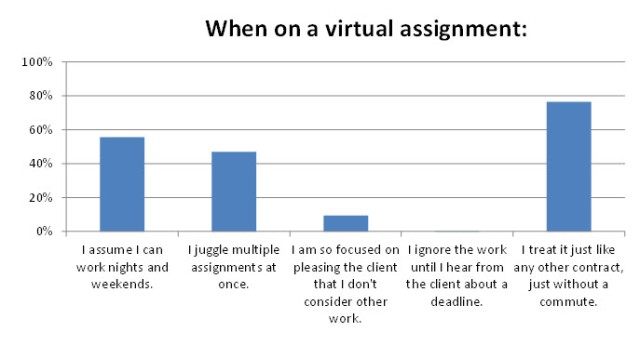Survey Results: Virtual vs. Onsite – Part 2

If you missed the first installment of this survey report, you can read it here. In the last blog, I covered the first three questions from my survey:
- Is working in an office is a distraction, or do you prefer to work in an office with colleagues?
- Which benefit of working virtually is more important to you?
- What drawbacks are the hardest part of working virtually?
Below are the results from the next few questions answered by 247 respondents:
Question 4: As a Virtual Worker, my office setup is:
My Assumption: I assumed that instructional designers working from home would have a complete office setup with current (within one year old) technology, if not the latest.
Surprises: None. Most respondents have a dedicated office space.
Interesting Comments:
- When I’m in my home office, I am at work. When I leave my home office, I’m on my own time. This is my cardinal rule.
- At times, I do work in other areas if I need a “change of scenery” but having a dedicated space is essential.
- This is one of my favorite things about working from home – I can set up my office however I want it. No cubicles. It is decorated however I want. And I have all the latest technology at my disposal.
Results Chart:
Question 5 – As a virtual worker, I update my hardware, software, and other technology:
My assumption: Again, I assumed most designers were like me. They pay for upgrades as their clients upgrade. You don’t want to get ahead of the client.
Surprises: I was actually surprised by the number of designers that use their current software/hardware as long as possible.
Interesting Comments:
- Well, not RIGHT away, but when a tool/technology gains enough credibility that I am confident it will be applicable to my big-business clients (who are often very slow/late in adopting new technology).
- By using my equipment/software as long as possible, I can keep my hourly/daily rates competitive. I will purchase software required by the client, however.
- I am an early adopter. I often have to ‘save down’ files for clients and printer because they have older software.
- I also keep older versions so that I am backwards compatible.
Results Chart:
Question 6 – This question explored whether virtual assignments were approached differently than on-site projects.
My assumption: I’ve seen this approached different ways by different contractors. Some contractors think virtual automatically means “extra side work” while others treat a virtual assignment as their only full-time contract. I expected the results here to be split.
Surprises: None.
Interesting Comments:
- Focusing on a single project works best for me and the client.
- Multiple projects are essential to my work flow. I typically have 3-5 projects running at a time and have to juggle my efforts to consistently meet deadlines.
- I usually work 3-4 projects at one time.
- I work the same hours as if I was in the office. If I have appointments, I work extra hours to get my 40 required hours in per week.
Results Chart:
What can we take from these responses?
As opposed to 15 or 20 years ago, almost everyone seems to have a complete home office setup. Laptops, printers, and other equipment are much less expensive, and almost everyone has the equipment required to work from home. However, companies do need to be aware that a large percentage of contractors juggle multiple clients. This is not a bad thing – just something to keep in mind when selecting a contractor. Employers need to make sure they are not bringing on a contractor with too many assignments. Contractors need to make sure they are clear with potential clients about technology requirements and workday availability.
This covers questions 4 – 6 on the survey. In the next blog, I’ll cover the survey questions about bill rates and staying in contact with the client.
Leigh Anne Lankford is an instructional designer with more than 22 years’ experience in the field of HRD. She is a Relationship Manager for TrainingPros in Atlanta, working closely with training and development departments of large organizations to identify, attract, and on-board contract employees for very specific and specialized training and development needs. You can reach Leigh Anne at leighanne.lankford@training-pros.com.



